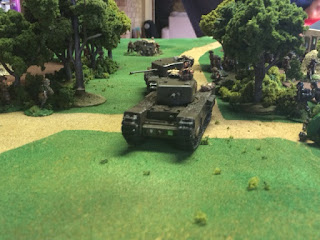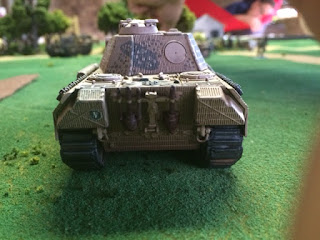First off, I
should state that North Africa is and always has been my favorite period of WW2
to game, actually just about anything set in the 20th century desert
environment is great. Okay, so this is a
new project. It started out as an off
shoot idea from a series of WW2 28mm skirmish games largely inspired from,
essentially three sources. The first was
the excellent series of scenario books published from Skirmish Campaigns and
the second was the relatively new Pint Sized Campaigns for the Chain of Command
WW2 skirmish rules by Too Fat Lardies. The
last was a move or notion by our little group to publish our own scenario
books, with a particular focus on the Canadian Army in Italy at Ortona defended by the German Paras.
In my mind,
the third idea is related to the first. Having
read many of the Skirmish Campaigns books, we knew that before we seriously
pursued publishing our own book we should at least take a good solid look at
constructing and playing at least one of the mini-campaigns in at least one of
the books.
So fast forward
a couple months; we decided on a specific book (Skirmish Campaigns - Monty’s
Epsom 1944) with a specific campaign we wanted to play; then we divided the
work. We knew that 28mm would be the
best scale for games set in the relatively compartmentalized terrain of Western
Europe for several reasons; the detail is awesome, the density of figures/vehicles
to terrain, weapon ranges to model size and finally the sheer volume and
variety of miniatures available in 28mm.
It is this idea, the visual enjoyment of the game that emerged as the
central impetus of this post; because after all miniature war-gaming is ultimately
a visual medium, one that is ascetically pleasing to the eye.
Fast forward
again, another 6 months. Having finished
all the required forces for the three scenario campaign in Monty’s Epsom book, “Royal
Tanks”, in 28mm, we are waiting to start playing. As of
today we are still coordinating a specific weekend to get together; we all live
a couple hundred miles apart and have families.
In the
meantime, and quite as another side line, I came to own a couple of new
armies. Thru a series of trades and
small purchases I acquired at first a small British 8th Army force
of 28mm Perry Plastics augmented by a couple 28mm Warlord Valentine tanks. My idea was to design a moving board campaign
(much like the 1812 Retreat from Moscow campaign in the Courier) featuring the
retreat of the Ramcke Brigade after 2nd El Alamein, as my brother
had just purchased a boxed set of Warlord Games German Paras. It was in researching how to model this
campaign game that I came to view some of the problems related, in general
terms, to gaming WW2 battles set in the North African desert.
Now to the
point. As anyone playing games set in
the desert knows, there is a disconnection of sorts when playing in 28mm,
especially in WW2 games. This scale
always looks odd on the relatively open terrain, especially when more than 5 or
6 vehicles are on the board. Tank to
tank battles just look out of scale to the amount of space to play or the ratio
density is just off. This then naturally
tends for players to account for this oddity by placing a focus on putting terrain,
most often buildings, hills or even an oasis of some sorts to break up the
engagement ranges; to compartmentalize the battlefield such as in European
settings. And once this happens, the
boards tend to just look strange and the battles themselves maybe not realistic,
at least in the minds of those that play.
Another effect I have noticed is the shift to irregular forces in
otherwise traditional “skirmish” settings, the SAS or LRDG or the one off
desert raid. Which again shifts away
from the ideas in average player’s minds as to what the war in North Africa
was.
Now this effect
can be mitigated by using smaller scales such as 15 or 20mm but then you enter
into a trade-off between visual ascetics of miniature war-gaming and the
realism of the game as a representation of a historical battle itself, as a
game to be played and ultimately enjoyed.
While I’m not 100% sure why this is, I would suggest that it has more to
do with the types of actions being modeled on the board and the failure in ability
to acquire the ascetic “feel” of the game as a game. Of the many desert battles our group has
played, observed either in person or on YouTube, blog pictures or whatever
medium, this disconnection can be felt but does not necessarily have a form
that can be identified specifically. It
just looks weird I suppose.
Putting the
Ramcke Brigade retreat moving board campaign aside for a moment, the key to
success in gaming North Africa in 28mm lay in 2 considerations that can be
distilled into pose (of the figure) and compositional context (forces shaped by
situation).
The second issue
is more complex so I will address it first.
It appears to be more about types of engagements or the context. Not just the attack defense model but
considering the composition of forces contextualized into game driven related
components; externalities if you will. Cutting
to the chase, tank to tank battles in 28mm will always look strange and be
difficult to model in an ascetically pleasing way. Also how realistic would it be for the fate
of 15th Panzer Division to be decided by a platoon of three tanks
versus two platoons of Grants at El Alamein in what would equate to a Walmart parking
lot? It would be unrealistic, visually
unappealing maybe strange and ultimately not fun. Instead I suggest that context and component
are more important when playing battles set in the desert with 28mm minis.
An
application for consideration. Enter
Skirmish Campaigns, in particular their North Africa scenario book. While clearly the scenarios contained are
intended for a variety of scales (book was published in 2004), a couple for
sure but maybe as much as 4 are great examples of the crux of what I’m suggesting. Rearguard at Benghazi and Point 209
illustrate that context drives composition.
In both of these, clearly designed for 15mm or maybe 20mm, the
Australians are defending a position, with a few Infantry and towed AT gun(s) against
a motorized/mechanized German attacker. While
I have not played either, both of these actually at least appear to be great
games for those seeking to play North Africa in 28mm. The German player doesn’t have masses of AFVs
to assault the Australian line, instead no more than 5. The remainder being composed of
externalities; specifically Motorcycles or Pioneers on foot or in a truck, the
playing surface is large, 4ft x 8ft and has the Germans attacking down the long
end towards the defending Australian line, all within variable conditions,
based on local tactical achievements of the models on the board.
To close the
loop on context and composition it should be stated that these two should be inter
connected or related. In the sense that
the desert is a big place, largely devoid of terrain that traditionally
compartmentalizes available space and the people and machines that occupy it
are relatively small in number. This is
in tension with the large 28mm scale miniatures especially when compared to the
relatively small amount (definitely finite) of traditional desert gaming space. Compare this to what many players
traditionally come to associate with or at least acknowledge exists in the
collective notion of common WW2 desert warfare; tank to tank battles, infantry
attacks on prepared positions or defending against armored attacks. Fact is that unless you have a massive space
in which to game 28mm desert tank battles, they will always look weird. This phenomena cannot be changed. So the question naturally devolves into what
types of games can tanks be used?
I believe
serious consideration should be given to games that use a template of sorts. One that is predicated on some level of local
on board achievements (good or bad, by attacker or defender) that combines to
create some sort of gaming unpredictability.
I suggest these: games where
meeting engagements never happen, there should be a definite defender (from
prepared on board positions) and attackers from variable entry points based on
time, achievements of initial attacking forces, or even on board defender
dispositions/deployments or activities.
There should also be reinforcements following the same design model.
Now back to
the first consideration, as it’s relatively straight forward. The poses of the
figures being used in 28mm desert games matters. This is why I really like the Perry plastics
for both Germans and British. Pose
matters in ascetically contextualized and component driven games. Honestly how realistic does it look when the
defenders are standing in an expanse of open desert? In front of an enemy who is attacking with
AFVs? Just so happens that the defenders would want to present as small a
target as possible, to which Perry’s figures can provide an inexpensive
alternative. Just build the defenders in
the kneeling or prone positions. The
figures can be placed in low profile foxholes or just in the open (ascetically
pleasing because it’s realistic). For
the attacking Germans riding in soft skinned vehicles, once they dismount
(which they will have to do because of the numbers of Bren Guns the Australians
have) the moving or standing figures from the boxed set are appropriate, again
because they are attacking. This is
predicated by the vast ranges of the weapons (in most skirmish rules), open
nature of the terrain and the large distance the Germans have to cover to win
the game.
So to tie up
the ideas. To successfully game the WW2
North African theatre, in 28mm, players should consider the following; the pose (form
related and relative to gaming space occupied) of the figures matters as part
of and in relation to the physical composition (appropriately tailored to
mission accomplishment) of the force and this is further connected to the context
(conditions in which the other 2 operate) into which they are placed as pieces
to either win or lose a game.

















